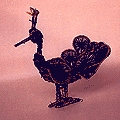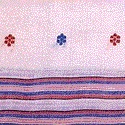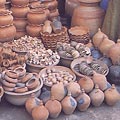Unhusked Rice/Paddy Craft of Odisha,
Oryzasative or unhusked rice has been used for making chains, figures of deities, animal figures, flowers, garlands and other objects. This painfully laborious craft - practised in some parts of Balasore, Koraput, Bolangir and Kalahandi in Odisha - requires meticulous attention and minute detailing. The prices levied for the products are exceeding low and not commensurate with the labour involved. No tools are required, rice grain and cotton cord being the only raw materials used. The origin of the craft is lost though the practitioners know that their families have been practising it for many generations and that there is ritualistic significance in the crafting of Goddess Laxmi. The use of paddy is also symbolic of prosperity, a good harvest and general well being.

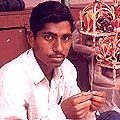
Oryzasative or unhusked rice has been used for making chains, figures of deities, animal figures, flowers, garlands and other objects. This painfully laborious craft - practised in some parts of Balasore, Koraput, Bolangir and Kalahandi in Odisha - requires meticulous attention and minute detailing. The prices levied for the products are exceeding low and not commensurate with the labour involved. No tools are required, rice grain and cotton cord being the only raw materials used. The origin of the craft is lost though the practitioners know that their families have been practising it for many generations and that there is ritualistic significance in the crafting of Goddess Laxmi. The use of paddy is also symbolic of prosperity, a good harvest and general well being.
PRACTITIONERS
The paddy craft is practised by the Ghond tribes of Odisha residing in Dumermunda near Kesinga of undivided Kalahandi district, Titilagarh, Kumudipadar and the Saraibahal area of Bolangir district of undivided Koraput. Barely 15 to 20 families practise the craft during lean agricultural months and the products are sold mainly at local haths (markets), though some of the artisans have access to urban craft bazaars.

PRODUCTS
The products painstakingly pieced together include images of Goddess Laxmi, elephants, vahanas (chariots), tribal marriage crowns, images of temples, hand fans and baskets.

TOOLS, TECHNIQUES
No formal tools are used and the raw material required is mainly unhusked paddy seeds of uniform size which is available locally. The artisan also requires thin bamboo sticks and strong yarn in red, green and yellow colour(s). The process involves tying by hand each individual paddy seed with the help of two thin bamboo sticks placed parallel to each other at a minute distance sufficient to hold the paddy seeds tightly in a straight line. This is a very painstaking and repetitive job that requires concentration and great dexterity. Each and every seed of paddy has to be individually knotted. In this manner straight lines are formed with different coloured threads and kept ready for the making of different shapes. The length of each of these paddy garlands is approximately one yard. About ten paddy garlands are required to create 30 pieces of Goddess Laxmi in a medium size. Each of these pieces is sold at a nominal rate. After household chores are over women and children usually perform the hard task of making the paddy garlands in their spare time; both the men and women then craft the final images.
The craft has been mentioned by T. N. Mukherjee in his book Art Manufacturers of India published in 1888 for the Glasgow International Exhibition. Mukherjee writes that chains made of unhusked rice were crafted in Gushkara village in Burdwan District of West Bengal. The difficulty in accessing the artisans in their relatively remote location is an additional difficulty in helping revive the craft.
Uppada Jamdani Saree Weaving of Andhra Pradesh,
The Uppada Jamdani Saree is woven in Uppada in the East Godavari district of Andhra Pradesh. It is known for its light weight and reversible design—after weaving the design appears on both the sides. Finest silk with pure zari is used as the raw material to weave the saree. Designs intermingled with the basic plain ground weave are the outstanding features of these sarees. Jamdani weaving is locally called “ani butta”weaving (“ani” means shed).
The Uppada Jamdani Saree is woven in Uppada in the East Godavari district of Andhra Pradesh. It is known for its light weight and reversible design—after weaving the design appears on both the sides. Finest silk with pure zari is used as the raw material to weave the saree. Designs intermingled with the basic plain ground weave are the outstanding features of these sarees. Jamdani weaving is locally called “ani butta”weaving (“ani” means shed).
Urli, Varpu, Charakku/Bell Metal Cauldron Casting of Kerala,
The Moosaris, one of the six categories of kammalas, are the traditional metalsmiths of Kerala, they trace their origin to Vishwakarma, the deity of all craftspeople. The Moosaris specialize in the making of cast bell metal utensils with thick cooking surfaces. Bell-metal, an alloy of copper and tin, and has a most attractive surface with an old gold tint that does not tarnish and needs no tinning. The Moosaris work in Thiruvananthapuram; Nadavaramba, Irinjalakuda, Kurmamkulam and Kadavallur in Thrissur district; in Manjapara in Ernakulam district; in Payyanur in Kannur district; and in Kasaragod The vessels cast include the urli and the varpu that are approximately 1 to 2 feet in diameter and are used in most households in Kerala for cooking payasam, the milk based delicacy. The large charakku, usually 3 to 8 feet in diameter with a surface thickness of as much as 20 mm are wide and shallow. They have handles on either side for ease of lifting. This king of vessels and is one of the largest cooking vessels to be cast by man. It is used in temples and at weddings and feasts for the preparation of large quantities of food a tradition that started with the practice of feeding hundreds of Brahmins and others during temple festivals and royal ceremonies. Using the cire perdue or lost wax method of casting, elaborate rituals and the propitiation of the gods traditionally accompany the casting. The process starts with invocations to Lord Ganapati and the ritual blessing of the axle, the core is made using a variety of clays, each of which is selected for its plasticity, bonding properties, strength or surface finish. The process of making the clay mould is so elaborate and laborious and the outcome of the solid metal mould so dependent on precise and careful handling of both the mould and the molten metal that special prayers and rituals are conducted throughout to ensure a perfect result. A mixture of pure beeswax, tree resin and castor oil, prepared according to traditional means, is pinched onto the core in rolls or beaten into sheet and applied. Gauges for resin thickness are affixed to ensure an even rim and a constancy of body. A heater tool is used to remove the access wax while the core is turned and surface motifs made of wax rolls that are carved out of wax plates are attached. Wax runners, made broad at the top and narrow at the joint and distributed so as to ensure a convenient and balanced inflow of metal are placed at intervals. Copper connecting pins are hammered into the wax, theseact as a support between the core and the outer mould. An outer clay mould is carefully executed and all edges are sealed. The firing involves two simultaneous activities - baking the mould and melting metal in crucibles. Metal is poured into conical openings while air escapes through strategically located vents, a process that may take up to two days. The mould is cooled and then broken to reveal the metal object. Smaller items like lamps and small household vessels are also crafted by the artisans.
The Moosaris, one of the six categories of kammalas, are the traditional metalsmiths of Kerala, they trace their origin to Vishwakarma, the deity of all craftspeople. The Moosaris specialize in the making of cast bell metal utensils with thick cooking surfaces. Bell-metal, an alloy of copper and tin, and has a most attractive surface with an old gold tint that does not tarnish and needs no tinning. The Moosaris work in Thiruvananthapuram; Nadavaramba, Irinjalakuda, Kurmamkulam and Kadavallur in Thrissur district; in Manjapara in Ernakulam district; in Payyanur in Kannur district; and in Kasaragod The vessels cast include the urli and the varpu that are approximately 1 to 2 feet in diameter and are used in most households in Kerala for cooking payasam, the milk based delicacy. The large charakku, usually 3 to 8 feet in diameter with a surface thickness of as much as 20 mm are wide and shallow. They have handles on either side for ease of lifting. This king of vessels and is one of the largest cooking vessels to be cast by man. It is used in temples and at weddings and feasts for the preparation of large quantities of food a tradition that started with the practice of feeding hundreds of Brahmins and others during temple festivals and royal ceremonies. Using the cire perdue or lost wax method of casting, elaborate rituals and the propitiation of the gods traditionally accompany the casting. The process starts with invocations to Lord Ganapati and the ritual blessing of the axle, the core is made using a variety of clays, each of which is selected for its plasticity, bonding properties, strength or surface finish. The process of making the clay mould is so elaborate and laborious and the outcome of the solid metal mould so dependent on precise and careful handling of both the mould and the molten metal that special prayers and rituals are conducted throughout to ensure a perfect result. A mixture of pure beeswax, tree resin and castor oil, prepared according to traditional means, is pinched onto the core in rolls or beaten into sheet and applied. Gauges for resin thickness are affixed to ensure an even rim and a constancy of body. A heater tool is used to remove the access wax while the core is turned and surface motifs made of wax rolls that are carved out of wax plates are attached. Wax runners, made broad at the top and narrow at the joint and distributed so as to ensure a convenient and balanced inflow of metal are placed at intervals. Copper connecting pins are hammered into the wax, theseact as a support between the core and the outer mould. An outer clay mould is carefully executed and all edges are sealed. The firing involves two simultaneous activities - baking the mould and melting metal in crucibles. Metal is poured into conical openings while air escapes through strategically located vents, a process that may take up to two days. The mould is cooled and then broken to reveal the metal object. Smaller items like lamps and small household vessels are also crafted by the artisans.
Utilitarian Products of Clay and Terracotta,
On any day of the week at the Potters' Square, just south of Durbar Square in Bhaktapur, a wonderful sight can be viewed. Thousands of pots are neatly lined up all across the square and in the shelters around the sides of the square with the potters busy at the wheel as they turn out more and more. Terracotta pots and containers of all sizes and shapes crafted by potters, locally known as kumhars/kumhale or kumbhakars, are on display. High round pots to hold grain, medium-sized one for water, other products serving as containers for tea, dishes for yogurt, holders for the coal of the smoking hookah pipes and oil lamps abound. The square itself has two small temples, a solid-brick Vishnu temple and the double roofed Jeth Ganesh Temple. The latter is an indicator of how long the activity all around the square has been going on as it is believed that the temple was donated by a wealthy potter in 1646 - to this day its priest is a potter. Pottery is very clearly what this square is all about. Under the shady open verandahs or tin-roofed sheds all around the square, the potters' wheels spin and clay is thrown. In the square itself, literally thousands of finished pots sit out in the sun to dry, and are sold in the stalls around the square and between the square and Taumadhi Tole.


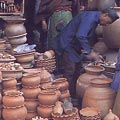
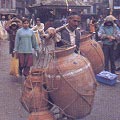
On any day of the week at the Potters' Square, just south of Durbar Square in Bhaktapur, a wonderful sight can be viewed. Thousands of pots are neatly lined up all across the square and in the shelters around the sides of the square with the potters busy at the wheel as they turn out more and more. Terracotta pots and containers of all sizes and shapes crafted by potters, locally known as kumhars/kumhale or kumbhakars, are on display. High round pots to hold grain, medium-sized one for water, other products serving as containers for tea, dishes for yogurt, holders for the coal of the smoking hookah pipes and oil lamps abound. The square itself has two small temples, a solid-brick Vishnu temple and the double roofed Jeth Ganesh Temple. The latter is an indicator of how long the activity all around the square has been going on as it is believed that the temple was donated by a wealthy potter in 1646 - to this day its priest is a potter. Pottery is very clearly what this square is all about. Under the shady open verandahs or tin-roofed sheds all around the square, the potters' wheels spin and clay is thrown. In the square itself, literally thousands of finished pots sit out in the sun to dry, and are sold in the stalls around the square and between the square and Taumadhi Tole.
HISTORY & TRADITIONS
The pottery craft of Nepal is of ancient origin. Archaeological excavations in the Kathmandu Valley and in Lumbini, the birthplace of Lord Buddha, have revealed shards of ancient pottery in red, brown, and black shades in remarkable designs These, it is conjectured, can be dated to the Buddhist chaityas of the first and second century BC. Terracotta temples, displaying superbly carved life-like motifs - built between the 14th and 18th centuries - have stood intact in Nepal for thousands of years. The motifs and polish used are almost unaffected by centuries of denudation.

PRACTITIONERS
The making of pottery is not only confined to the hereditary caste of the kumhale but is also practised by farmers at lean agricultural times as an additional source of income. There is a brisk sale of pottery in Nepal during the winter season. The pots are reasonably priced and if no ready cash is available they are be bartered for food-grain. The potters themselves carry their pots in baskets strung on to pole across the shoulder and reach almost every house in winter to sell their produce. These potters - from Kathmandu, Bhaktapur, and Thimi can be seen on the streets usually before festivals.
PROCESS & TECHNIQUE
Pottery clay is found in both the Kathmandu Valley and in the Pokhara Valley. Depending on its plasticity a selection of clay is made by the potter. After mining, the big lumps are crushed and the dry clay is stored as it needs to be kept away from the sun for a week so that is does not lose its moisture and pliability. Like manufacturers everywhere the potters are most worried about the supply of raw material. In the old days, the dyo-cha/ black clay could be had for the asking. Most of the clay used to come from the village of Sipadol towards the south of Bhaktapur. The potters exchanged earthenware with the farmers for clay from their fields. Now, with the building frenzy, and as more and more rice fields are buried under concrete, the potters haplessly watch their supply of clay disappear.

The Nepalese technique involves mixing black clay with local gicha clay in equal proportions and adding one-tenth of its weight in sand. The whole mixture is kneaded by foot to a dough-like consistency. The kneaded clay is kept in a damp and dark place till it is required. For the wedging a lump of clay is rolled until the potter is satisfied with its plasticity.
Various styles and types of pottery products are crafted in Nepal using techniques - such as hand-forming, coiling, moulding, and the throwing - that suit the requirement of the product that is to be crafted.
In Nepal, the hand-forming technique is used to make, among other things, small terracotta products like the oil-fed lamps or palas, used in Hindu temples and homes all over Nepal - these palas are lit to celebrate the festival of lights, Dipawali.
The coil pottery technique is used in Nepal to make large storage pots and basins for washing (attals). These large pots are crafted by shaping the clay first by hand and then by beating them into shape with a wooden mallet. In this technique the potter starts at the bottom and then builds upwards, layer by layer, by adding lumps of clay to the edges, painstakingly raising and shaping the wall of the jar, after each addition of clay, until the required height is obtained. Between each addition of clay the potter waits for the mass to harden before raising the wall further. When the required height is reached, the vessel is left outside to dry in the sun. In order to ensure that the walls of the jar are of uniform thickness the potter beats the inside and the outside surface with a wooden mallet. A smooth finish is obtained by rubbing the surface, while the rims and edges are smoothened with water.

This coiling technique is sometimes coupled with the throwing technique on the potter's wheel. This is usually done while making water storage pitchers. In making such pitchers, the potter uses the wheel to build the shape of the thick walled vessel and follows it up by hammering the clay inside and outside to get the final shape and size. The beating is done at the same point from both the inside and the outside. Very fine sand is used to coat the mallet to avoid it from sticking to the clay surface while beating. This process is known as batting.
Wooden, terracotta, and Plaster of Paris moulds are used for making those products that cannot be shaped on the potter's wheel. Smoking pipes (chilims) and hexagonal fire-pots (makal) are made using this technique. A lump of clay is uniformly hand pressed against the inner walls of the mould into which fine sand has been sprinkled. The form, when baked, comes off the mould when it is turned upside down. A wide range of products with complicated shapes and designs are produced by this method; by joining different parts and kneading the joint edges together by hand, complex terracotta products are built up.
The throwing technique has its roots in antiquity. The potters use a large wheel of hard wood, which is similar in design to the Indian wheel that is supported on a wooden pivot and rotated with a long wooden pole. The wooden wheel is now being rapidly replaced with the ingenuous use of a discarded truck tire! The potter places a lump of clay at the centre of the wheel, the wheel is rotated swiftly, and the potter uses both hands to shape the pots, using the outward and upward motion. The finished pot is sliced off the wheel with a cotton thread or wire and kept aside for drying in the shade, though the final drying is in the sun. Often the pots are polished by rubbing their outer surface with a smooth fruit seed (lekh pangra), while the bottom of the pot is beaten to give it its final finish. At all times the potter has to ensure that the pots do not crack The height and diameter of the vessels are measured using traditional bamboo or straw, while the application of the clay-mud slip is made with a cloth swab. The dry pots are then stored for firing.

The famed black terracotta of Nepal is also made on the potter's wheel. However to achieve this unusual look the potter adds a few more steps to the process of production. When the pot is sliced off the wheel and dried and hardened completely, it is placed on the wheel again and the outer surface is rubbed with lekh pangra or with a horn till the surface acquires a glossy shiny finish. It is then fired in an open kiln. When the firing is about to be completed all the openings are closed and the pots are baked in the enclosure with an insufficient supply of oxygen. This produces a great deal of smoke inside the kiln and carbon particles get deposited on the outer surface of the pots, imparting a shiny black surface to the vessels. The potters of Bhaktapur and Thimi are famed for their skill in producing the black pottery. Traditional black pottery items include soma, dhelancha, and thyakacha.
Firing of the pottery is usually done before the advent of winter. The pottery is fired at a temperature of about 600-8000 C. This low temperature firing of the pots produces weak earthenware. At this temperature the pots are basically baked and they acquire a reddish tone and produce a sound when tapped. Great care needs to be taken in their arrangement and movement as they are only bisque-fired.
The pots are fired in the open, either in courtyards or in the fields. The potters use rice and wheat straw, with a thick layer of about one foot of it spread on the ground. Large sized pots - often the water pots - are placed over this layer in a circular fashion. Another layer of straw and dry grass, about six inches thick, is spread over them. Next, a layer of slightly smaller pots like the washing vessel (attals) is placed over this. In this manner several alternative layers of dry straw and pots are stacked carefully. Small items are placed at the top and covered again with straw and dry grass. Thus these pots are arranged in rows with the big ones forming the bottom layers and the smaller ones on top in alternating layers to a height, 4-5 feet. The whole stack is covered with a one-foot thick layer of straw and dry grass. Finally the entire stack is covered with about a four-inch thick layer of ash. The layer of ash applied outside has a two-fold function: it to prevents the air draft; and maintains the heat inside the kiln for a longer period. The finished kiln resembles a small mound and at its base two or three holes are made with long sticks. The fire is lit at the bottom and the firing continues usually for about 24 hours. The potter controls the rate of flow of oxygen and allows the straw to burn slowly. If there is an excessive supply of oxygen the straw burns too rapidly, leaving the pots unbaked. As the fire rises slowly upwards the pots are baked. The potter keeps a constant watch on the kiln and manipulates the heat by making two or three holes in the upper part of the kiln to help the baking by introducing more air drafts. A dark red heat is seen inside the kiln and the temperature reaches around 600-7000C. When the whole stack burns completely and no more smoke comes from the kiln, it is allowed to cool for two days. The pots are taken out individually and the ash deposited on them is removed. The pots are now ready for sale.
PRODUCTS
The product range includes high round pots to hold grain, massive liquor vats, medium-sized ones for water, products serving as containers for tea, dishes for yogurt, holders for the coal of the smoking hookah pipes and oil lamps. In addition to the traditional household utensils there are candle-sticks, ashtrays, sacred images and masks, and elaborate flower pots. One of the most popular items is a flower pot shaped like an elephant, with a hollow in the elephant's head to plant flowers.
In present times pottery is largely crafted for utilitarian purposes. These large container jars, water pitchers, lamps, washing bowls, flowerpots, vases, smoking chilims and objects used in religious ceremonies are some of the products being produced. Farmers store their agricultural produce in large earthenware jars for protection from rodents and damp. The jars are also used for water storage and for carrying water from the well and water spout. One of the most important pottery categories is the making of lamps. Clarified butter (ghee) fed lamps are burnt on special festive occasion such as Dipawali, the festival of lights. Lamps are lit while worshipping in temples and for various Hindu and Buddhist rituals, and the use of lamps in homes is also an old tradition. Besides earthenware, other clay products such as bricks, roof tiles etc. are produced in great quantity all over Nepal.
Uttarayan and Kites of Gujarat,
Uttarayan is the most jubilant festivals in Gujarat where the entire city lights up with kites in the sky. Gujarat is the hub of paper kite craft production and manufacture. Patang is the local word for a kite. The largest hub of kite production is Gujarat. Vadodara, Surat and Ahmedabad are the majr cities which are known for their kite markets. Kites for Uttarayan are made from a special lightweight paper which ads velocity to the flight of the kite. The kite festival in Gujarat is an amazing spectacle. People from all over the globe come to enjoy the sight of the vibrant colours and patterns on these kites flowing in the air. The craft production of the kites dates back to the historic reign of the Mughal empire. The first centers of production were set up in Ahemadabad. The community of people who indulged in this craft was called Patangbaaz. The initial shape of the kite was that of a prism and has slightly evolved since then. Earlier candle or qandeel were also used to add to the velocity and glory of the flying kite. Today one can see kites of various types depending on the purpose. They are commonly engineered in quadrangular shape for better mobility and control to the kite flyers. [gallery ids="176422,176425,176421,176420"]
Uttarayan is the most jubilant festivals in Gujarat where the entire city lights up with kites in the sky. Gujarat is the hub of paper kite craft production and manufacture. Patang is the local word for a kite. The largest hub of kite production is Gujarat. Vadodara, Surat and Ahmedabad are the majr cities which are known for their kite markets. Kites for Uttarayan are made from a special lightweight paper which ads velocity to the flight of the kite. The kite festival in Gujarat is an amazing spectacle. People from all over the globe come to enjoy the sight of the vibrant colours and patterns on these kites flowing in the air. The craft production of the kites dates back to the historic reign of the Mughal empire. The first centers of production were set up in Ahemadabad. The community of people who indulged in this craft was called Patangbaaz. The initial shape of the kite was that of a prism and has slightly evolved since then. Earlier candle or qandeel were also used to add to the velocity and glory of the flying kite. Today one can see kites of various types depending on the purpose. They are commonly engineered in quadrangular shape for better mobility and control to the kite flyers. [gallery ids="176422,176425,176421,176420"]
